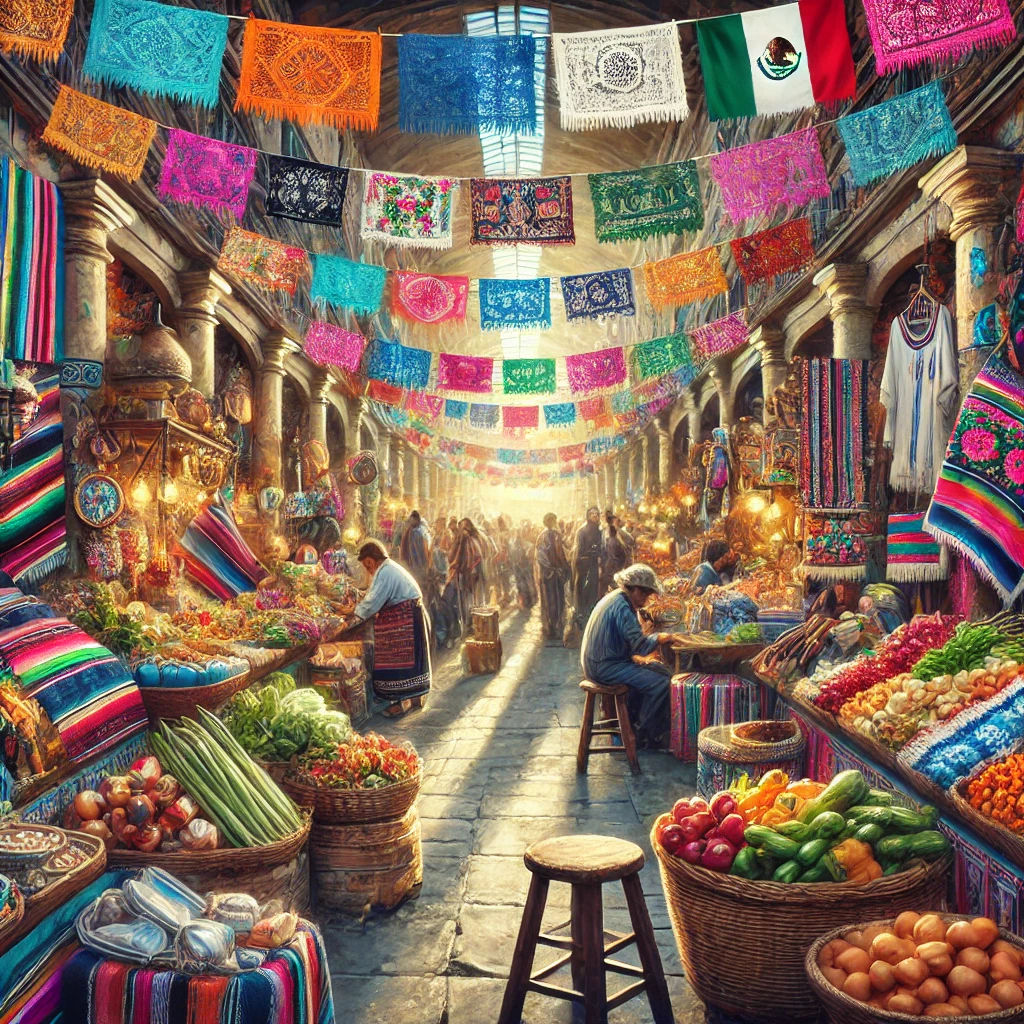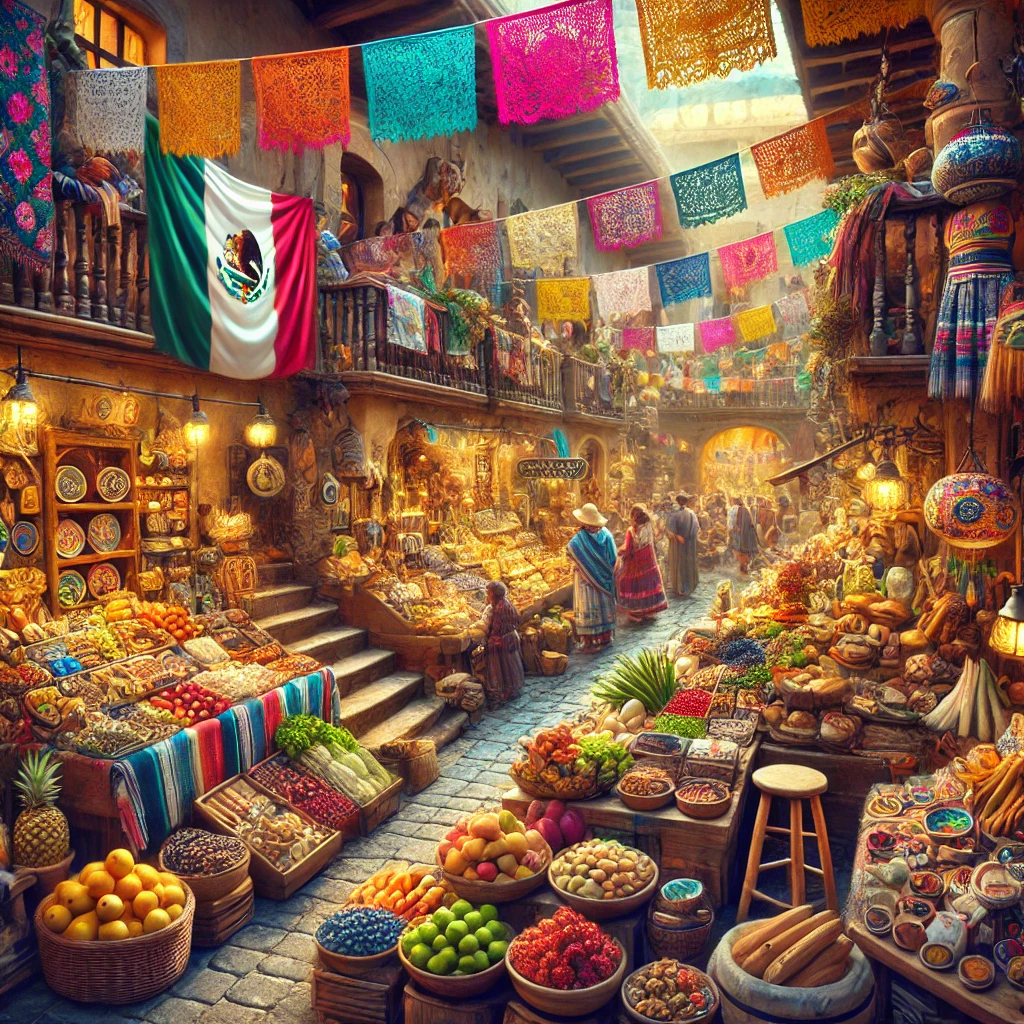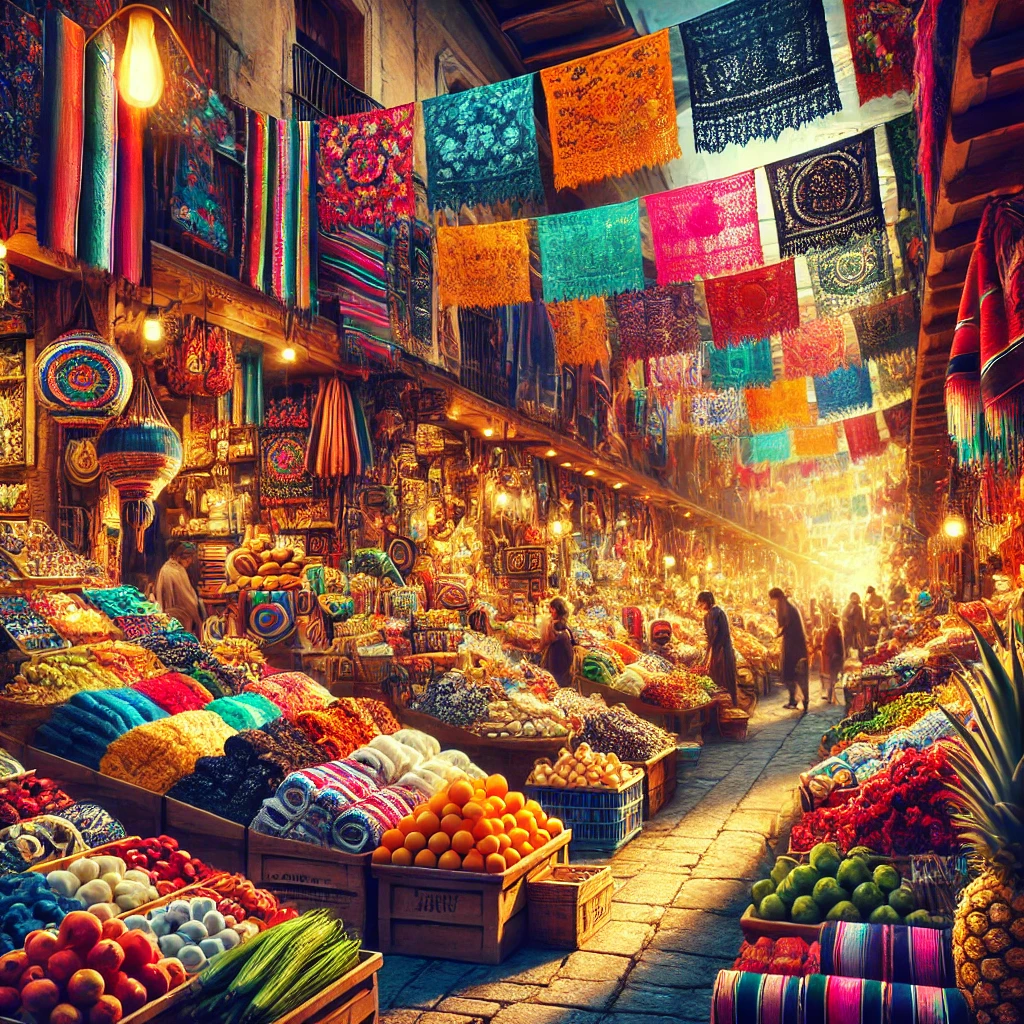Table of Contents
Introduction to Mexican Markets
The vibrant world of Mexican markets is a testament to the country’s rich cultural heritage and community spirit. These bustling spaces, found in almost every town and city, serve as not just a hub for commerce but also as a gathering place for social interaction, cultural exchange, and local traditions. Whether it is a lively street vendor selling fresh produce or an artisan bazaar showcasing handcrafted goods, these markets offer a unique glimpse into the life and identity of Mexico.
Mexican markets come in various forms, providing a wide array of products to capture the interest of both locals and tourists alike. Open-air markets, known as “tianguis,” are commonly found in urban areas and typically operate on specific days of the week. These markets often feature an assortment of goods, including fresh fruits, vegetables, herbs, and numerous items crafted by skilled artisans. Beyond the food stalls, shoppers can also find clothing, pottery, jewelry, and more, all steeped in the traditional methods of production.

In addition to tianguis, there are specialized artisan markets, such as the famous markets in Oaxaca and Guadalajara, which are renowned for their handmade crafts. These bazaars celebrate the unique artistic talents of their regions, offering textiles, woodwork, and ceramics that reflect Mexico’s diverse cultures. Culinary markets also play a significant role, offering not just fresh produce, but also gourmet products, spices, and local delicacies meant to tantalize the taste buds.
The experience of wandering through a Mexican market is enhanced by the vibrant atmosphere, characterized by colorful displays, lively music, and the delightful sounds of bartering. Each market encapsulates the essence of Mexican life, showcasing the culinary delights and artistic creativity that define the nation. This exploration of Mexican markets brings forth not only an opportunity to shop but also to engage with the warmth and hospitality of the local community, making each visit a memorable experience.
Types of Markets in Mexico
Mexico is renowned for its vibrant culture, enriched by a diverse array of markets that cater to various needs and preferences. The most notable types of markets include traditional markets, artisan fairs, farmers’ markets, and night markets, each offering a unique shopping experience for both locals and tourists.
Traditional markets, known as “mercados,” are the heartbeat of communities across Mexico. These bustling places are typically held in large open spaces or enclosed buildings and feature a plethora of stalls selling everything from fresh produce to household goods. Visitors can expect to find vendors passionately showcasing their locally sourced fruits, vegetables, meats, and spices. Moreover, traditional markets often serve as gathering places for social interaction, reflecting the heartbeat of the community.
Another popular type is the artisan fair, which highlights Mexico’s rich craftsmanship. These fairs often occur during holidays or festivals, showcasing handmade goods such as pottery, textiles, jewelry, and folk art. Artisan fairs enable local artisans to promote their creative talents while preserving traditional techniques passed down through generations. Shoppers can appreciate unique items that tell a story, making them perfect as souvenirs or gifts.
Farmers’ markets, or “tianguis,” provide a different flair, emphasizing organic and sustainable farming practices. These markets typically take place weekly and feature seasonal produce, handmade foods, and often local crafts. The emphasis on fresh and organic products supports local agriculture, allowing consumers to connect with farmers directly.
Lastly, night markets have gained popularity in urban areas, offering a lively atmosphere filled with street food, entertainment, and late-night shopping. These markets often feature food stalls serving traditional dishes and snacks, allowing visitors to savor authentic flavors well into the evening.
Each of these market types reflects the diversity of Mexico’s culture and its dedication to preserving its handmade traditions and local produce. Exploring these markets can provide an immersive experience into the daily lives and traditions of the Mexican people.
Handcrafted Goods: Artistry and Tradition
Mexican markets are vibrant hubs of culture, teeming with an impressive variety of handcrafted goods that reflect the rich artistic heritage of the country. These markets offer a unique glimpse into the skill and creativity of local artisans who dedicate their lives to preserving traditional crafts. Among the most notable of these goods are pottery, textiles, and leatherwork, each representing a unique aspect of Mexican culture.
Pottery, often characterized by its colorful designs and intricate patterns, is one of the oldest art forms in Mexico. Influenced by pre-Hispanic traditions, artisans in regions such as Oaxaca and Talavera produce exquisite pieces. These handcrafted items not only serve functional purposes but also tell stories of the people and the land. The use of natural pigments and age-old techniques highlights the commitment to preserving tradition, showcasing the artistry that has been passed down through generations.
Textiles are another vital aspect of Mexican craftsmanship, with each region boasting its distinctive styles and techniques. From the vibrant, hand-woven rugs of the Zapotec people to the intricate embroidery found in traditional blouses known as “huipiles,” the creativity embedded in these textiles reflects the cultural narratives of communities. These fabrics are often made using indigenous materials and traditional looms, fostering a sense of identity and belonging, while also supporting local economies.
Leatherwork, particularly from regions like León, is renowned for its quality and craftsmanship. Artisans create a wide range of products, from belts and bags to footwear and decorative items, using time-honored techniques that emphasize durability and design. The leather goods produced are not only functional but are imbued with the stories of their makers, representing a connection to the land and its traditions.
In essence, the handcrafted goods available in Mexican markets are more than mere items for sale; they are artifacts of cultural expression that serve to preserve the rich heritage of Mexico. Each piece carries with it a narrative rich in history, artistry, and tradition, making these markets a treasure trove for anyone interested in experiencing the true essence of Mexican culture.
A Culinary Journey: Fresh Food and Local Delicacies
Mexican markets are a vibrant tapestry of colors, aromas, and flavors, offering a delectable selection of fresh produce and local delicacies. As one wanders through the bustling stalls, they will encounter an array of fruits and vegetables, many of which may be unfamiliar yet enticing. Destined to capture any culinary enthusiast’s attention, these fresh ingredients play a crucial role in prepared dishes that epitomize the essence of Mexican cuisine.
Among the vast offerings, one can find an abundance of tropical fruits. Pineapples, papayas, mangos, and avocados are often displayed in eye-catching arrangements, creating a feast for the senses. Vegetables, too, are plentiful; vibrant tomatoes, crisp bell peppers, and earthy squash serve as foundational elements in traditional recipes. Paying a visit to these markets not only allows for the selection of the freshest produce but also for an opportunity to engage with local vendors who are often more than willing to share their knowledge on the optimal use of these ingredients.
Timing is critical for those seeking the finest specimens. Early morning visits are generally recommended, as this is when farmers and vendors showcase their newly harvested items. Moreover, markets usually hold special significance during specific seasons, such as Día de Muertos or Christmas, where one can find seasonal specialties, like pan de muerto or unique sweets, that are cherished in Mexican culinary traditions.
Food in Mexico transcends mere sustenance; it embodies cultural identity and community spirit. Meals are often communal experiences, fostering connections among family and friends. Each region contributes its unique flavors and traditions, making every visit to a Mexican market not just a shopping trip, but a cultural exploration. In conclusion, the culinary journey that Mexican markets provide is an enriching experience that connects visitors to the heart of local cuisine, showcasing the importance of fresh ingredients and regional specialties in everyday life.
Bargaining and the Art of Negotiation
In the vibrant landscape of Mexican markets, bargaining is not merely a transactional practice; it is a cultural tradition that emphasizes interaction and relationship-building. Vendors often expect customers to negotiate, seeing it as a natural part of the shopping experience. To engage in successful bargaining, a respectful and friendly demeanor is crucial, as this fosters a positive atmosphere and encourages vendors to be more flexible with their pricing. Being polite and displaying a genuine interest in the goods can lead to a more amiable negotiation process.
One effective strategy is to start by inquiring about the item’s origin, craftsmanship, and value. This not only demonstrates respect for the vendor’s work but also provides you with an opportunity to express admiration for their craft. Utilizing phrases in Spanish, such as “¿Cuánto cuesta?” (How much does it cost?), followed by a friendly smile, can enhance rapport. After receiving the initial price, it is common practice for buyers to offer a counter-price. It is advisable to offer a price that is reasonable yet lower than the asking price to initiate the negotiation without causing offense.
Anecdotes abound in Mexican markets where implicit social norms govern how bargaining unfolds. Vendors often expect playful banter, and this exchange can foster a genuine connection. For instance, a customer may joke about the price, and in return, the vendor might lower it in the spirit of good humor. Such interactions contribute to the overall unique experience of shopping in these markets, creating a sense of community around the exchange. Ultimately, building a relationship with local vendors enhances not only the shopping experience but serves as a memorable reflection of the cultural richness inherent in Mexican markets.
Experiencing the Atmosphere: Sounds and Sights
Visiting a Mexican market is an experience that engages all the senses, creating a captivating atmosphere that resonates long after leaving. The vibrant colors that adorn the stalls, from the deep reds of fresh tomatoes to the brilliant yellows of handcrafted textiles, create a feast for the eyes. This vivid palette reflects the rich cultural heritage of Mexico and showcases the artistry of local craftsmen and farmers. As you stroll through the market, your gaze is drawn to beautifully woven baskets, intricately designed pottery, and colorful papel picado, each item narrating a story and reflecting the creativity of its maker.
Alongside the stunning visuals, the sounds of the market add to its lively ambiance. The chatter of vendors, each calling out their wares, creates a symphony of voices that blend harmoniously with the laughter of shopping families and the occasional strumming of a guitar. The rhythmic clinking of coins and the rustle of shopping bags punctuate the air, immersing visitors in a vibrant tapestry of communal life. This lively atmosphere invites interaction, enticing passersby to sample fresh produce or to barter for unique handcrafted goods.
Additionally, the scents wafting through the market are an essential part of the experience. The rich aroma of fresh herbs, spices, and sizzling street food blend with the sweet notes of ripe fruits, drawing visitors deeper into the marketplace’s heart. These scents evoke memories and create a longing to indulge in the culinary delights that await, making it impossible to resist the temptation of sampling local delicacies. The overall sensory experience is what imbues the Mexican market with its enchanting magic, creating a vibrant, inviting setting that encourages exploration and discovery.
Supporting Local Communities: The Impact of Market Shopping
Shopping at local markets presents a unique opportunity to directly support the artisans and farmers of the surrounding communities. By purchasing handcrafted goods and fresh produce, consumers play an integral role in sustaining local economies. This practice not only helps maintain traditional craftsmanship but also contributes to the livelihood of many families who rely on these markets for their income.
Local artisans often pour their creativity and culture into the products they create, whether it be textiles, pottery, or folk art. These handcrafted goods are not mass-produced; rather, they are the result of skill passed down through generations. When individuals choose to buy these items, they help preserve cultural heritage while providing a sustainable income for the creators. This form of economic support allows artisans to continue their craft and innovate new designs, enriching the community’s cultural landscape.
Additionally, market shopping encourages sustainable agricultural practices. Many vendors at local markets cultivate their produce with environmentally friendly methods, focusing on organic farming and reducing the use of chemicals. By choosing to purchase from these growers, consumers are not only obtaining fresh and healthy food but also supporting practices that are beneficial to the land and biodiversity. This helps to create a resilient local food system that can withstand the challenges posed by industrial agriculture.
Furthermore, the economic benefits of shopping at local markets extend beyond individual transactions. The money spent in these settings often circulates within the community, contributing to broader economic growth. Local markets act as gathering places, fostering a sense of community spirit and connection while driving job creation. Thus, the impact of market shopping ideally reverberates throughout the entire community, promoting a cycle of prosperity that benefits everyone involved.
Tips for Navigating Mexican Markets
Visiting a Mexican market can be an exhilarating experience filled with vibrant colors, enticing aromas, and an array of handcrafted goods. To make the most of your market visit, preparation is key. Understanding what to expect and how to navigate these bustling environments will enhance your experience considerably.
Before heading to a market, spend some time researching which local markets are worth visiting. Each market boasts its own unique offerings, from artisan crafts to fresh produce. Identifying specific markets can help you discover the variety of goods available and potentially uncover hidden gems. Additionally, check the market hours; many markets operate only on specific days of the week, so confirming their schedules is essential to avoid disappointment.
When preparing for your visit, consider what to bring. A reusable shopping bag can be quite handy for carrying your purchases, while cash in small denominations is often preferred by vendors. Credit cards may not be accepted, particularly at smaller stalls, so it’s wise to have enough local currency on hand. Basic Spanish phrases can also enhance your interactions with vendors, helping you negotiate prices or learn more about the products.
Safety should never be overlooked when venturing into busy markets. Stay aware of your surroundings and keep your belongings secure, as crowded spaces can attract pickpockets. Traveling with a companion can add an extra layer of security, allowing you to keep an eye on one another’s belongings.
Lastly, remember to engage respectfully with vendors. A friendly conversation can go a long way in establishing rapport and may even lead vendors to share more about their crafts or produce. Showing appreciation for their work fosters a positive atmosphere and enhances your market experience. By following these tips, you can navigate Mexican markets with ease and enjoy all that they have to offer.
Conclusion: Embracing the Magic of Markets
Visiting Mexican markets offers a truly enchanting experience that transcends mere shopping. These vibrant hubs are alive with color, sound, and the spirited interaction of vendors and customers, weaving a tapestry that reflects the rich cultural heritage of Mexico. Each market possesses a unique charm, inviting visitors to explore its winding aisles, where the aroma of freshly prepared food mingles with the scent of handcrafted goods, creating an irresistible atmosphere that captivates the senses.
The sense of community found within these marketplaces is remarkable. Locals gather to exchange not only goods but stories, traditions, and smiles, fostering connections that go beyond commerce. This communal spirit is evident in the friendly chatter amidst the stalls, as vendors enthusiastically share the history behind their crafts, whether it be ceramic pottery or handwoven textiles. By supporting these artisans, shoppers contribute to the preservation of cultural practices that have been passed down through generations.

Moreover, Mexican markets are a treasure trove of flavors and sensations, offering a diverse array of fresh produce, spices, and street food that is both authentic and delicious. Each visit can be an adventure into the culinary delights of the region, showcasing seasonal ingredients that are often sourced from local farms. This emphasis on fresh, high-quality food not only supports local sustainable practices but also elevates the overall dining experience.
As you embark on your travels or explore your local community, seek out these magical markets. Embracing the vibrant culture and community spirit they offer can enrich your journey, leaving you with lasting memories and a deeper appreciation for the local traditions and craftsmanship. Undoubtedly, the experience of shopping in these markets will inspire and invigorate, making them an essential aspect of any cultural exploration.






Valuable information. Fortunate me I found your web site by chance, and I’m shocked why this twist of fate did not happened earlier! I bookmarked it.